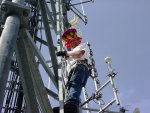Merovingian
Member
- Joined
- Sep 17, 2006
- Messages
- 206
Yeah, but that's Tessco's "chump" pricing for people that don't have an account. Cheaper if you have one.
But, absolutely, but it somewhere else. Much cheaper.
Heh. I've got an account with them, I logged in and that was the price they gave me. I ordered some from eBay much, much cheaper.
I've got a few sites down along the coast, salt spray, lots of rain, fog, hurricane force winds, etc. That tape hasn't failed (yet) and it's been up there several years.
Industry standard is to do a wrap of electrical tape over the entire connection from above the connector, half overlapping, to a few inches below the connector and then reversing to the top again. Known as "Half lap and back". Follow that up with a layer of the self fusing tape, starting just above where the tape stops below the connector and working towards the top, again, half lapped. Mold it in well around the connector. Follow that up with another "half lapped and back" layer of electrical tape.
It takes time to do right, but it works. Removing it is as easy as cutting it off with a razor blade and peeling it off.
Very important, though. Some antennas have "weep holes" in the bottom to allow condensed moisture to escape. Make sure you do not block those.
You can get wide roles of electrical tape that makes it a bit easier. You can even purchase "kits" that include everything you need in one package.
Waterproofing coaxial connections is often overlooked by hobbyists. There's some assumption that finger tight connectors are magically waterproof. They aren't.


